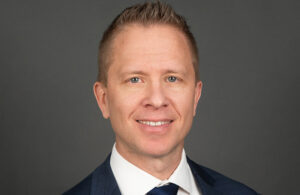
Isometric Micro Molding CEO Donna Bibber [Photo courtesy of Isometric Micro Molding]
The pending acquisition by Nissha Medical Technologies will give a big boost to Isometric Micro Molding’s manufacturing of miniaturized medtech used in robotic surgery, diabetes and other growth markets, executives from both companies said.
Medical Design & Outsourcing discussed the deal with Isometric Micro Molding CEO Donna Bibber, Isometric VP of Business Development and Strategy Brent Hahn, Nissha Medical Technologies Chief Integration Officer and Chief Supply Chain Officer Jon Casey, and Nissha Medical Technologies EVP Brandon Hoffman. The following interview has been lightly edited for space and clarity.
MDO: What will Nissha Medical Technologies and Isometric Micro Molding be able to do together that they couldn’t do before?

Nissha Medical Technologies EVP Brandon Hoffman [Photo courtesy of Nissha Medical Technologies]
Hoffman: Our relationship with Isometric is new. Obviously, we’ve had pre-transaction conversations on where we think we can go. We’ve aligned at a very high level, but we have a lot more planning to do and execution to do. Generally speaking, Nissha’s focus has been moving into more sophisticated minimally invasive devices. We did a deal fairly recently with EndoTheia, a technology that is in late-stage development for navigation and steering. Our intent is to use that as an enabling technology for steerable devices: could be interventional devices, could be visualization, could be on robotic platforms or standalone navigated devices, those sorts of applications. We’re working to finish that development and our intent is to bring that into the portfolio. Look at Isometric’s capabilities for very small, micro part manufacturing, the mechanical parts those small devices need, whether in the distal end or the proximal end, on robotic platforms, in devices, guiding devices. When we’re talking medical device — because there are other verticals that we are getting exposed to and Isometric is already exposed to — at a very high level, that’s our intent to move forward. And we’re going to continue to develop that platform technology both on the micro forming side and then also on enabling technologies in steering and navigation.
MDO: What does this mean for Isometric’s team? Do you have plans for growth?
Bibber: We definitely do. We’re at 125 employees [in New Richmond, Wisconsin] and growing very quickly. We’re planning another building here very soon because this one is getting pretty full. But more of the same: we do a lot in robotic surgery, sensors, ophthalmic and diabetes. Those are our four main markets today, and we just see those continuing to grow. Where I see the big picture with Nissha is helping out with that new technology that was acquired last month. EndoTheia is certainly something that needs miniaturization. Everything’s getting smaller, and we’re really positioned well for all of those markets that I just spoke of and new ones as well. Thinner and thinner parts that are 1,000 parts per plastic pellet and have extremely thin walls still need to have sensors in there somewhere. We’re well-positioned to squeeze everything into a small space. And that’s really where we come in, not just on the micro molding side, but on the automation side as well. Taking that part coming out of the mold, putting it on the backside of the molding machine, bringing other parts to it and bringing the full solution, vertically integrated with respect to the full-on device.
MDO: How does Isometric fit in with Nissha?
Casey: When we look at Nissha Medical Technologies and our eight medical manufacturing facilities, one of our existing core capabilities of five core fundamental capabilities to Nissha worldwide is molding. However, the vertical integration and benefit that Isometric brings — alongside everything Brandon illustrated and Donna outlined — is those micro-level tolerances. As we continue to add those capabilities, their know-how and knowledge in this space is ideal as we continue to commit to pushing the boundaries of innovation in the medtech space and really follow our pathway, what we call our Strategic Vision 2030, to significantly grow our medical device business unit within Nissha Co., our parent. There’s a very good core capability fit … and complementary synergies not only from a production, operations and market perspective, but also from a culture and community perspective. We really found a lot of value in the know-how and the people at Isometric.
MDO: What’s some of the most exciting work Isometric’s doing?

Isometric VP of Business Development and Strategy Brent Hahn [Photo courtesy of Isometric Micro Molding]
Hahn: What we’re doing more and more is extremely high aspect ratio molding. We’re molding aspect ratios up to 400:1 and doing it in extremely difficult materials like PEEK. We’re now molding PEEK at 7/1,000ths thick, and it allows for a very rigid material to be flexible because we’re able to hold it in such thin wall thicknesses. We’re able to work with materials in a different way that was never thought possible and allowing something very rigid to be flexible for metal replacement, which can be very advantageous and allows for continuing to advance thin-wall molding — which we incorporate under our micro molding — allowing medical OEM and drug delivery companies to really think outside the box and innovate what they’re using to go forward. We’re molding sharps down to 3 microns in sharpness. Some people have a hard time measuring that. A human hair is 100 microns in diameter. Ultra, ultra sharps, making sure there’s no flash, making sure it’s fully filled (no non-fill) and then working with extremely difficult engineering-grade resins that are typically not used in these type of applications, these thin walls and micro features.
MDO: How about some closing thoughts on this deal from everyone?
Hoffman: For our approach to the market as a CDMO, our ability to go from early design concept to support whether it’s enabling technology or high-value, very engineered components such as what Isometric can do, we layer that on top of our macro capabilities — macro assembly, automation platforms for assembly — and then combine that with on the process side what Isometric can do on the micro side — micro forming, micro assembly — it creates a real value proposition, particularly for those looking at novel solutions for devices, diagnostics and drug delivery. We can do that within our large footprint and really use them as an innovation center at the micro level. We’re quite excited to bring that to market. We think it’s a fairly unique proposition.

Nissha Medical Technologies Chief Integration Officer and Chief Supply Chain Officer Jon Casey [Photo courtesy of Nissha Medical Technologies]
Casey: This acquisition is more than just an agreement. It’s a partnership and a platform for growth. When I look at pushing the boundaries of innovation in medical devices, we have an appetite for growth. We’ve announced this as our third acquisition in the past 30 days. As we focus in on the miniaturization of devices and our expertise continues to develop in surgical navigation and visualization, we’re excited about more to come, what this partnership brings, and especially our growth goals together with Isometric and our other new partners.
Bibber: I’m really excited for our collective teams to cross-pollinate with respect to high-precision devices. I love that there’s design capability, because that’s something that we haven’t had. So I think that full value pyramid is something that we’re always striving for: the intellectual property right at the top, and enabling our customers to use that intellectual property to get to the top of their game with a platform that does something that’s not deemed to be possible before — what we do in miniaturization. I’m really excited about the team and having the global outreach, having 250 engineers worldwide to tap into. It’s an exciting time.
Hahn: This partnership and acquisition allows us to grow the way we want to grow. And that’s so impactful to our customers — and ultimately to patients … to have the ability to grow to meet their needs and take on even more challenging projects in miniaturization.